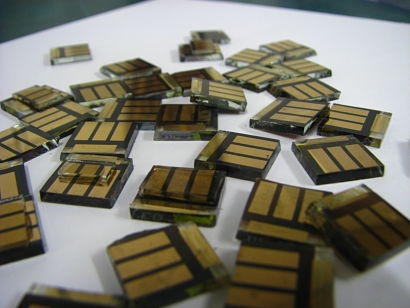
Perovskites are potential alternatives to conventional silicon-based solar cells as high-performance photovoltaics. However, instabilities due to ion migration limit their commercial viability. Now researchers from Korea and the USA have used an imaging technique to observe structural changes at the atomic level suggesting strategies to reduce perovskite solar cell degradation.
Perovskite solar cells (PSCs) represent the next generation of solar cells owing to their low costs and high-power conversion efficiencies. However, they tend to degrade quickly. As it turns out, when the PCSs are exposed to sunlight, freely moving ion vacancies form in the structure and migrate towards the electrodes. In dark conditions, the effect is reversed, and the ions are once again redistributed in the perovskite structure. Repeated cycles of this ion transport during the operation of the solar cell permanently degrade the cell and result in short lifetimes. However, degradation at the atomic level due to ion migration has not been directly observed.
Now researchers from Korea and the USA have successfully observed changes in the perovskite structure using an in-situ transmission electron microscopy (TEM) imaging technique.
“This work offers vital insights on understanding ion migration and addressing instability challenges of perovskite optoelectronics” said Assistant Professor Min-cheol Kim of the Department of Mechanical Engineering, Pusan University, who led the study that was published in the journal ACS Energy Letters on September 14, 2021.
While electron microscopy has the scope to image structures at the atomic scale, the instability of the perovskite structure towards an external electrical bias (voltage) makes it challenging to monitor it for structural changes. The researchers circumvented the problem by imaging perovskites under a stable voltage. They first prepared a thin layer (or lamella) of a nano perovskite solar cell. The lamella was placed between the electrodes of an electronic chip and a stable voltage was applied across the sample. This setup enabled the researchers to stimulate the photovoltage experienced by the solar cell under working conditions. A constant voltage of 1 V was applied across the lamella and the structure was monitored by TEM.
The researchers observed a gradual disappearance of the lattice fringes of perovskite crystals, which indicated the ‘amorphisation’ of the structure. As is the case with perovskite crystals, amorphisation was observed to be reversible under dark conditions. However, using TEM, the researchers noticed that recrystallisation was faster when the sample was subjected to mild heating at 50°C.
“This work not only demonstrates the ability to achieve real-time imaging of perovskite amorphisation but also provides an effective method to recover the degraded performance of PSCs related to ion instability” added Professor Kim.
Elucidating the changes in perovskite structure could enable researchers detect points of failure and build more resilient solar cells. In addition, observing the rate of recrystallisation can help determine the effectiveness of strategies used to restore the performance of solar cells.
For additional information:

